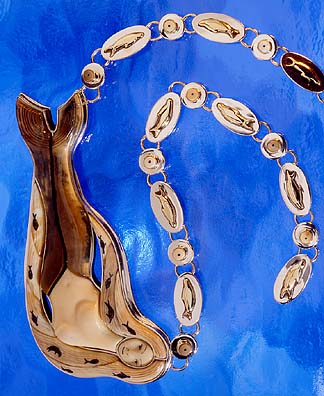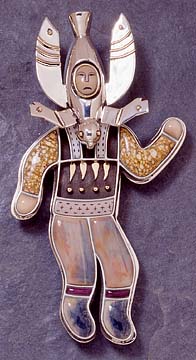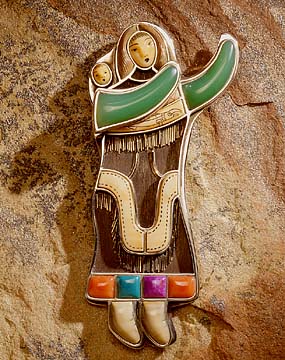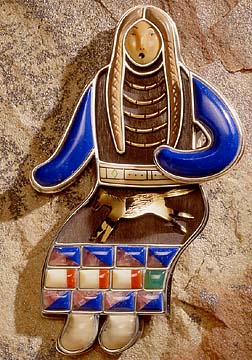


Local Color![]()

|
Alaskan folklore
Wallace workshop
inspires native artistSedna, the mother of sea beasts in Alaskan mythology, was a beautiful mortal girl who was too haughty for her own good. Whenever young men tried to court her with fancy gifts, she turned her back and refused to utter even a word.
She always managed to find flaws in her suitors: This one's too short or that one had bad teeth. Marriage wasn't on her mind; what seemed to matter to her the most was grooming her luxurious long, black hair.
Her father finally had enough of her bad attitude and laid down the law: Marry the next young man, whomever he may be, or else. The next day, a young man, his face hidden beneath snow goggles and the hood of his fur jacket, appeared in a kayak. He too had heard of her beauty and promised her a splendid house insulated with thick layers of animal furs.
The newlyweds set off in his kayak but they did not live happily ever after. Her home turned out to be nothing more than a heap of twigs and driftwood perched on a high rocky ledge. Once the clothing came off, Sedna discovered that her husband was not only ugly and squat but also a storm petrel, a small black bird, disguising itself as a human.

|
Just when she thought her life couldn't get worse, her father chopped off her fingers as she clutched a kayak while escaping her husband. The first joints of her fingers became the first seals and the second joints became the first walruses. The remaining finger parts turned into whales.Sedna sank to the bottom of the ocean, still living and bitter. She guards her sea creatures jealously, calling up storms to prevent men from hunting them. Without fingers, she could no longer comb her hair, leaving her in a worse mood.
In traditional native practices, the most powerful shaman is called upon to appease Sedna when she's angry. In ceremonial rituals, he must undertake a deep sea voyage made more ominous with rolling boulders and evil spirits. To soothe Sedna's rage and pain, the shaman must comb her hair until it is clean and smooth before she releases the sea creatures for humans.

|
This story has been told countless times in countless versions over the ages, and it has given Alaska artist Denise Wallace a rich legacy to draw upon for her one-of-a-kind jewelry.Wallace, who now lives and works in Laupahoehoe on the Big Island, is a celebrated Native American artist whose award-winning work is sought by collectors.
Wallace, whose creations cost several thousands of dollars each, is a storyteller who uses ivory, stones and metals to recreate the folklore of her Aleutian ancestors as well as other Native Alaskan peoples. Her techniques are a combination of traditional methods, such as scrimshaw and bone carving, and modern silversmith and lapidary work.
Most of Wallace's work is figurative. The Alaskan men and women in native dress are made with sterling silver, 14- or 18-karat gold, ivory (legally collected from fossilized sea animal bones and walrus tusk), and semi-precious stones. Each figure may be worn as a pin or pendant, and sometimes the figures have detachable parts that may be worn as separate pieces of jewelry. Often, the figures may be linked together to form a elaborate belt. (A belt requires 10 to 20 figures.)
Wallace, 46, is half Sugpiaq and half German. She grew up in Seattle but visited her relatives in Alaska often. She studied art at the Institute of American Indian Arts in Santa Fe, N.M., and fell into jewelry making to supplement her income. Her husband, Sam, is her partner and specializes in the lapidary work. Her son and daughter also help and make their own jewelry.

|
In a necklace based on Sedna's legend, Wallace used fossilized walrus tusk, choosing a light color for her face and body and darker tones for her hair and mermaid tail. The seals, walruses and whales in her hair are scrimshawed onto the ivory."I am inspired by the people, (the) animals and the natural environment of the Northwest Coast and Alaska," Wallace said. "My pieces tell a story, whether it is about a simple Alaskan basket weaver or about a complicated deity like Sedna. I find jewelry is the best way for me to tell the stories of my people.
"The story gets transmitted through the people who buy my jewelry. When they wear the pieces, the stories get retold."
The family's move to Hawaii two years ago was the result of collaborative work with Hawaiian artists in projects involving native and Polynesian artists. She found immediate kinship with the isle's rich folklore and Hawaiian beliefs in treating nature with reverence, she said.
Denise Wallace does not exhibit her work in Hawaii. Instead her pieces, limited to about 30 a year, are shown and sold through selected galleries and crafts shows on the mainland. But she will be sharing her work and knowledge in an ivory-carving workshop and free public lecture sponsored by the University of Hawaii's Art Department through its Intersections Visiting Artist Program. Wallace workshop
The workshop will be held 1 to 5 p.m. April 9 in the Sculpture Studio at the art department. Cost is $10 and covers materials. Registration is required. Call 958-8251 for more information.
The lecture will be held 7:30 p.m. the same day in the department's auditorium.
Gardening Calendar
Suzanne Tswei's art column runs Sundays in Today.
You can write her at the Star-Bulletin,
500 Ala Moana, Suite 7-210, Honolulu, HI, 96813
or email stswei@starbulletin.com